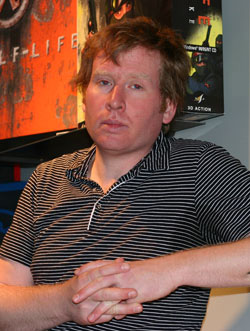Tom Leonard
| Tom Leonard | |
|---|---|

| |
| Biographical information | |
| Title(s) |
|
| Time period |
April 2002 – February 2013[1] |
Tom Leonard is a software and game developer who worked for Valve.
Biography[edit]
- "Before joining Valve, Tom was the CTO of Buzzpad, Inc. Before that, he spent five years at Looking Glass Studios where, as Lead Programmer, he wrote the AI and core architecture for Thief: The Dark Project. Tom also spent seven years working on C++ development tools at Zortech and Symantec. He's been at Valve since 2002, working on design and technology for Half-Life 2, Episodes One and Two, and Left 4 Dead."
- ―Source (August 4, 2012)
Work[edit]
Leonard was responsible for core Source engine technologies, including the memory allocation system, save/restore system, threading and profiling tools. He developed core AI in Half-Life 2 and the Episodes, writing parts of the AI for the Zombies, the Citizens, the Metrocops, the Strider, the Combine Soldiers,[1] and the cut character Odell.[2]
Along with John Guthrie, Dario Casali, and Steve Bond, he built the Canals and Ravenholm.[1][3] He also worked on the chapters Anticitizen One, and "Follow Freeman!".[1]
Leonard led the effort to get Half-Life 2 on the Xbox, including CPU optimization, memory optimization, and custom allocators. He contributed to the redesign of portions of the game that were outside the capacity of the Xbox.[1]
For Episode Two, he refactored and rewrote the Source engine for multicore architectures, spearheaded CPU-side optimization for the Xbox 360, and co-designed several levels and AIs,[1] such as The White Forest Inn and the Hunter.[4]
Leonard conceived, planned, and led the Directed Design Experiments. Along with John Guthrie and Steve Bond, he demonstrated their idea of modular artificial intelligence, where creatures could be assembled from components at runtime and exhibit novel emergent behaviors.[1]
For Portal 2, he built an abstract binding layer and infrastructure to allow Source to seamlessly integrate with multiple scripting engines, and developed "VScript", the foundation of Portal 2's gameplay behavior, and the tool used to implement GLaDOS.[1]
He was a strategic and a tactical planner for Source 2, developing core architecture and designer tools.[1]
Selected gameography[edit]
- Half-Life 2 (2004)
- Half-Life: Source (2004)
- Half-Life 2 (Xbox port) (2005)
- Half-Life 2: Episode One (2006)
- Half-Life 2: Episode Two (2007)
- Portal (2007)
- Portal: Still Alive (2008)
- Portal 2 (2011)